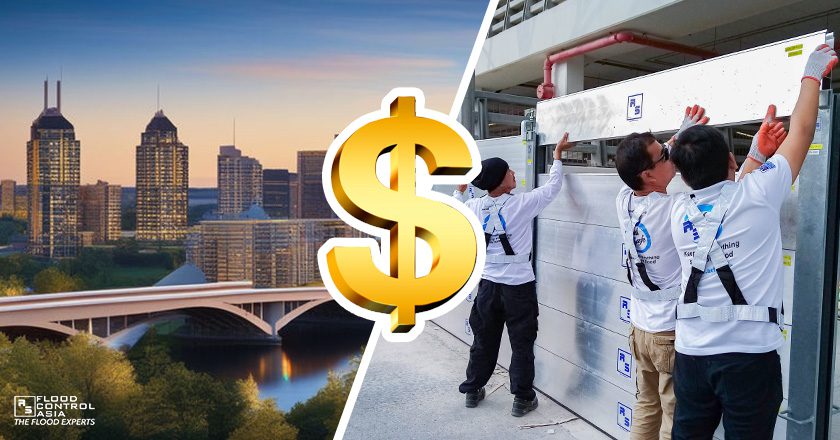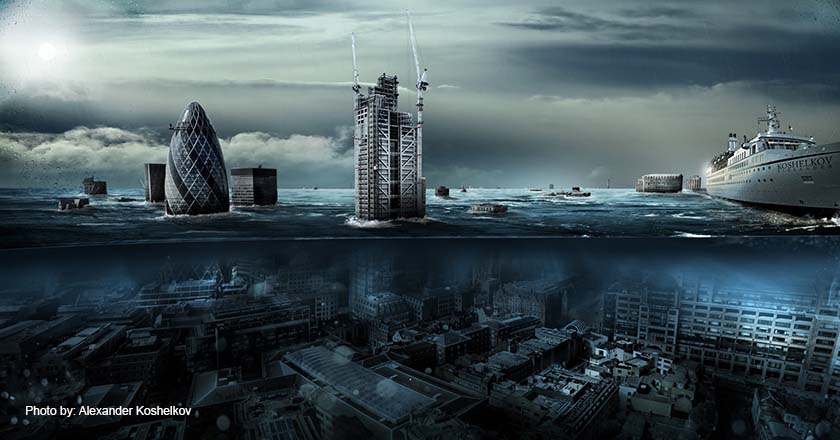Finding Calm in the Storm: A Personal Journey with Flood Barriers
January 12, 2024 | Created by: Andreas Klippe | Comments

A man pondering whether to employ traditional or contemporary methods for flood protection.
Emotional rather than practical aspects of choosing the right flood barriers often lead homeowners to protect their loved ones and their possessions: the house, the yard, the garage. It is the place where they live. With the increasing impacts of climate change, it is becoming increasingly important to make decisions in the face of natural disasters. But call it what you will: heavy rain and flooding threaten homes and families. Something has to be done about it.
Introduction
Today, I’m sharing a very personal story – a personal journey with flood barriers, a path that led a Philippine couple in the 60s from fear to calm in the midst of nature’s unpredictability. This is the story of Ms. Kristina and Mr. Pedro Luega from the Province of Bulacan in the Philippines.
Part 1: The Onset of Fear
Because they lived near a flood-prone area, the threat of natural disasters was always on their doorstep. The fear was palpable – every rainstorm, every flood warning triggered a feeling of dread. It wasn’t just about water entering their home. This happened not once but twice.
Even today, with a secure home, Ms. Kristina begins to shake violently and breathe rapidly when a storm rages over her home, when thunder and lightning challenge people, when Mother Nature shows her brutal power.
What was the reason?
It was the realization that she had lost her sense of security and the seemingly hopeless lack of protection that frightened Ms. Kristina.
Part 2: Seeking Solutions
First, Kristina and her husband Pedro installed some handmade wooden boards. You’ve seen it on the Internet. It looked easy to produce it yourself. They went to the local carpenter and the next day the wooden planks were delivered and installed in front of their three entrances to their house: the main door to their living room, the back door and the wider sliding patio door. After successfully testing the installation, they removed the wooden planks and stored them. Ms. Kristian knew: Now we are protected. At least that’s what she thought.
Then it happened. The next storm was approaching. Ms. Kristian and her husband Mr. Pedro quickly installed the wooden boards. The final plank was installed from the inside of the house.
And then they waited.
After an hour, the first water flowed across their street. The neighbors were all in a panic. Not knowing what to do, they cried out for help and prayed to God.
Not so couple Kristina and Pedro: They had their wooden boards and were therefore reassured.
After another hour, the water entered her yard and approached her front door. But suddenly, within a few minutes, they could see a small trickle of water breaking under their front door and moving into their room.
How could that happen? She would still be protected. They had bought wooden boards from the carpenter and laid them as best they could.
The next 12 hours were devastating and unbearable. The water covered the entire ground floor. It rose and rose, reaching the level of her knees. Ms. Kristian and her husband Pedro began to cry and were completely distraught. But it didn’t help. They had to do something.
They tried to move some of their belongings to the upper floor, but in vain. They didn’t think the water would move the tables and chairs. In the end the entire furniture floated and no longer stood. That’s why the television fell into the raging waters in their house. The furniture, the refrigerator, the vases with flowers, accessories like the television: everything was completely destroyed.
________________________
“They understood that
wooden planks cannot protect a house from flooding.”
________________________
Determined to confront this fear, they began researching the 14 best flood protection systems in the world. They had to learn that their decision would not only protect their property but also restore their peace of mind. It was a journey of discovery, not just of products, but also of personal resilience.
Part 3: Building Emotional Resilience
They found removable flood barriers. These barriers are made from stackable aluminum with horizontal and vertical seals. But could they withstand the force of water pressure?
So they examined them more closely and found that the products were originally developed in Germany. So far so good. German quality is known. But it still doesn’t answer their question: Will they withstand the destructive water pressure? Or will Ms. Kristina and her husband Pedro be flooded again?
To make a long story short: Ms. Kristian and her husband Pedro were satisfied. RS demountable flood barriers have been tested and certified through the world’s toughest U.S. insurance company certification process. This insurance company, FM Global of Boston, USA, only certifies products that meet all relevant chemical and physical requirements.
This insurance company is the world’s largest insurance company for industrial and commercial buildings. The business owners only receive an insurance contract if they install certified products. Why?
Insurance isn’t stupid. The lower the risk of damage, the lower the obligation to pay the insurance premium to cover damage.
In this case it means: As soon as the customer uses certified RS Demountable Flood Barriers, the risk of a building being flooded is negligible.
And that was what made it different from all the other flood barriers they had considered, starting with the wooden planks and many other aluminum or metal barrier systems. They all looked good, but only “when the sun is shining.” The true power of a flood barrier becomes apparent during heavy rain and flooding. And only the certified flood barrier made it onto the shortlist for Ms. Kristina and her husband Pedro.
Part 4: The Power of Informed Decision-Making
Pedro did some research and suggested to Kristina, “Why don’t we visit the company? They have their Asian headquarters in the Philippines, right by Clark International Airport. We’re lucky, we live in the Philippines. It’s close and we don’t have to take a plane.”
They called the office of the Asian headquarters and agreed to visit them next Tuesday at 10:00 am.
When they arrived they were shown around. Everything looked good. And suddenly Ms. Kristina and her husband Pedro could see, touch and feel other types of flood barriers, not just the removable flood barrier. They were shown a flood protection gate with a lifting hinge, a flood gate with a pivoting hinge, a barrier with a rotating hinge and the Inero Mobile Flood Barrier. They were all there. Even backflow valves and drain plugs in various designs were shown. What a difference to see the flood protection walls in reality and not just in a photo. So they had a good feeling even before testing the removable RS flood barrier.
Head of Business Development Alvin Baking gave them a tour of the showroom and explained in detail the types of barriers and how they work. He also mentioned what maintenance work should be carried out to achieve the target “100-year lifespan”.
But then came the most important thing: the “Rubber Duck Test”.
What is it?
It is a hydrostatic test with a real water column. “The barriers are 4.5 meters long,” Alvin Baking told the visitors. “Such a system has already been installed in Canada. Here we test up to 1.2 meters. This makes it possible to fill the water basin with an appropriate amount of water in a reasonable amount of time.”
Barrier beam after barrier beam was installed in the model, then the compression clamps were tightened. This is easy to do even for a customer’s grandmother. And then Alvin Baking ordered, “Fill the water.”
The water was poured into the water basin behind the flood barriers that had been built. And then what the visitors had hoped happened: water no longer crept out from under the barriers like it had previously through their apartment door.
The flood experts – now Ms. Kristina understands why they use that name – continued to fill up the water. Half a meter, a meter, finally 1.2 meters. And no water crept under the flood barriers.
“Impressive,” exclaimed Ms. Kristina. “The water actually didn’t pass through that barrier. Why didn’t we decide earlier to build flood barriers instead of these wooden boards?” she asked her husband Pedro. And Pedro added: “I already knew that products like elevators, fire extinguishers, trains and airplanes are certified before they can be used and that they have to be certified year after year. This certification is relevant to people’s safety. But now I understand that flood barriers also need to be certified. If they fail, we could drown and be dead.”
However, one final question remains: “Why is this test called the Rubber Duck Test?”
Alvin Baking, the flood expert, replied with a smile on his face: “Ma’am, Sir: Now, at the end of our hydrostatic test, we let our Rubber Duckie float on the water in the water basin. We really want to show that this is not a fake. Sometimes you don’t see the truth in videos. And that’s why we let our rubber ducky swim. Now look at it floating up and down with some waves I make with my hand.”
Ms. Kristina immediately said: “I declare this rubber duck test passed.”
Alvin was grateful for another successful demonstration of how truly safe flood barriers work.
After two months, when the construction of these flood barriers were completed, a change began for Kristina and Pedro Luega. With the installation, her fear subsided and was replaced by a growing confidence. These barriers were more than just physical defenses. They were symbols of a proactive stance against the fury of nature.
“Making informed decisions about flood protection provided a sense of empowerment. I wasn’t just responding to a threat, I was preemptively protecting my home and family. This process taught me the importance of understanding the risks and taking control where I could,” Pedro told RS Flood Experts after a few months.
Part 5: The Calm After the Storm
“When the flooding in our neighborhood due to heavy rains occurred again after a few months, I witnessed the strength of our decisions. Our home remained dry, but more importantly, my wife and I remained calm. The barriers held, as did our emotional strength. It was a victory over the physical and psychological effects of the floods.”, said Pedro Luega.
Part 6: Sharing the Knowledge
Through these experiences, the flood experts also learned how important knowledge sharing is. It’s not just about having the right barriers, but also about understanding how they work and the security they provide. This knowledge is power, a power that they share with others to help them find peace.
Conclusion
This flood barrier journey is a testament to the power of facing fears and making informed decisions. It’s not just about the barriers themselves. It’s about the peace of mind and emotional resilience they bring.
This was the story of Ms. Kristina and Mr. Pedro Luega from Bulacan Province in the Philippines.
They now live in a secure home. And they are no longer afraid when the weather forecast announces a violent low pressure area with heavy rain. They sit in their home and enjoy life while the neighbors are still looking for help.
And after the storm, Kristina and Pedro Luega still have their hard-earned money, their retirement savings. On the other hand, if you don’t have certified flood protection, you will spend all your savings on cleaning up the mess in your house, garden and garage, renovating it and buying what was destroyed again. This will never happen to the Luegas again.
Golden Nugget
Remember: the right flood protection can make all the difference. It’s not just a physical shield. It is a tool for building emotional strength in the face of natural disasters.
Please write your questions or comments in the comment field. I would be happy to answer.
Here comes my last question for you: Was the last flood you experienced higher than your knees or deeper?
If the answer is YES, then TALK TO THE RS FLOOD EXPERT TODAY!
However, if the response is NO, yet you aspire to be a proactive citizen, then reach out to the RS FLOOD EXPERT TODAY!






